I ate at HAGS, a queer fine-dining restaurant in NYC. The delicious food and fun atmosphere made me excited for the future of high-end eating.

- I went to HAGS, a queer fine-dining restaurant in NYC.
- While the food was innovative, the atmosphere was what really blew me away.
The first time I heard about HAGS, I immediately knew I wanted to go try it.

Considering it feels like I have a radar attached to my skull that seems to ping every time a new queer restaurant or bar opens up near me, I was disappointed that I was even just a few weeks late to the announcement of HAGS back in July 2022.
Telly Justice and Camille Lindsley — the duo behind the eatery in Manhattan's East Village — promised in an interview with Eater that HAGS would be a queer space first and a restaurant second. The all-caps name is a nod to both "old haggard witchy women," and the nostalgic acronym for "have a great summer," they said.
"As queers in this industry, we have barely survived by being quiet and invisible," Justice told Eater about the name. "We had to resist that urge to be small and inoffensive with our first restaurant if it were ever going to be a meaningfully safe space."
But the quirky and queer personality doesn't stop with those four letters printed on the door and menu.
When I arrived at the 20-seat restaurant, I immediately picked up on the intimate yet friendly atmosphere.
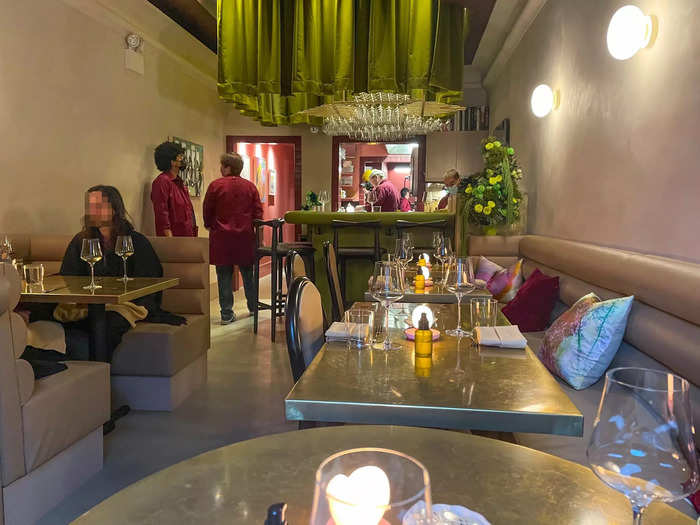
Even before I ate, I knew that this dinner would be unlike many other fine-dining experiences I'd had.
The kitchen is open to any substitutions and will meet various dietary restrictions; staff members are encouraged to interact with diners on a friendly level; and each detail, from the dishware to the table-clearing brushes (which are made by visually-impaired folks, according to our server), comes from artists or artist collectives that the staff seems proud to support (because, of course they are). To a queer person — OK, to me, I don't want to speak for everyone — all those details scream, "This is your place!"
To secure my table, I had to plan ahead— reservations get released at 12 p.m. ET on the first of the month, for the following month. So I did some strategic Resy checking and booked myself and a friend entry into this currently one-of-a-kind eating experience.
Each table was set with a heart-shaped light, a dish of pronoun pins, and hand sanitizer.
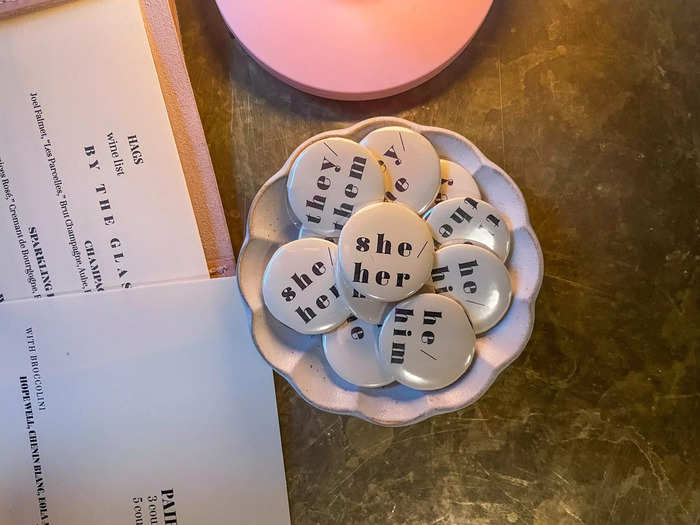
I was seated at a round table in the front corner of the restaurant. It was a cozy and intimate setting that would have been perfect for date night or catching up with a good friend — luckily for me, I was there for the latter.
The dish of pins on the table had different pronoun combinations on them so that diners could choose which felt most authentic for them and wear them during the meal if they wanted. Employees were sporting the pins, too, which I thought set the welcoming tone of hey, it's cool, pick a pin!
In my opinion, a queer space is somewhere that's welcoming and somewhere that's encouraging you to bring your most authentic self to the table. This small (and maybe insignificant to some) dish of pins tells you that queerness is, in fact, paramount to the identity of this space.
HAGS offers two menu options, and I went with the five-course tasting menu.
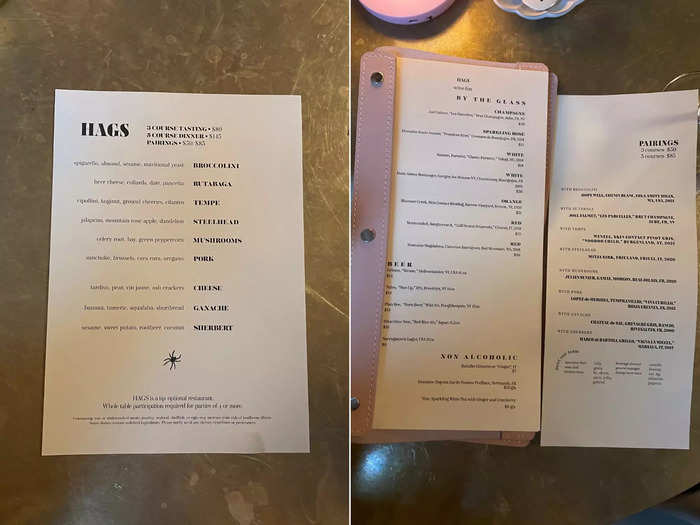
The menu boasts two options: a five-course dinner for $145, and a three-course tasting for $80.
Additionally, diners can opt for an $85 five-course wine pairing or a $50 three-course pairing.
In a city where fine dining can cost upward of $400 per person, the menu at HAGS seems enticing and, perhaps more importantly, accessible.
Many of the queer ticketed events, membership clubs, and other pay-to-enter spaces and services I've encountered employ a sliding-scale payment system. It supports the understanding that some aspects of queer life impact individuals' finances to different degrees, and the belief that those circumstances shouldn't impede someone's ability to participate in the community.
While the presence of two under-$150 menu options at HAGS (plus its optional tipping policy where service is included in the price of each meal) undoubtedly invites more of a wide audience, and the team goes one step further with pay-what-you-can Sundays. Each Sunday, chef Justice serves up meals on a donation-based fee model. They also offer glasses of wine from all open bottles for a flat, per-glass rate.
But during regular service (Tuesday through Saturday from 5 p.m. to 10 p.m.), the team asks that all parties at the table opt for the same meal option. So on this evening, my friend and I each ordered the five-course menu — without the wine pairing.
We divided up the menu so we could each try as much as possible. But before course one came out, a dish of pickles was delivered and we ordered house-made focaccia.
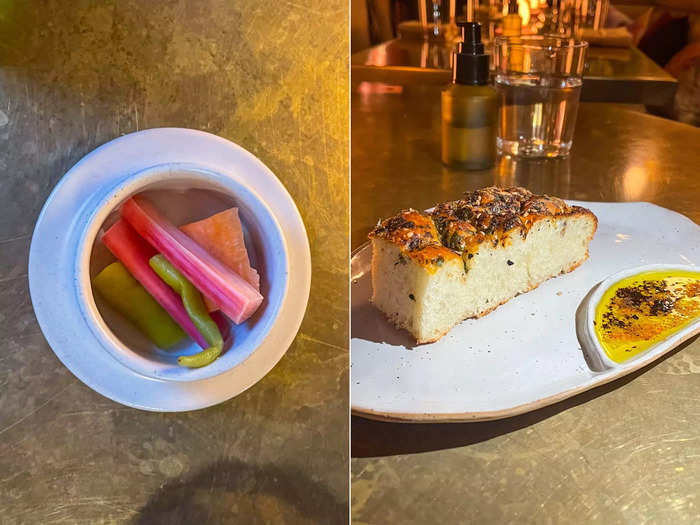
I tried the pickled rhubarb, peppers, and carrots, and I thought it was a great way to start the meal. They were all bright, acidic, and really got my taste buds going and excited for what was to come.
Our server asked if we wanted to add an order of chile tarragon focaccia to our meal for $6 and, of course, we weren't going to turn that down.
The bread was warm, fluffy, and beautifully aromatic. The bottom and sides were caked in sesame seeds, and the top was dusted with tarragon. It came in a specially-made dish with a separate section for the olive oil, which was seasoned with black Urfa chili.
I thought it had the perfect amount of saltiness to help the ingredients shine without becoming overly saturated. I could taste the quality of the olive oil with its beautiful fragrance and velvety smooth texture. I thought the overall flavor profile of the focaccia was filled with warmth from the herbs.
An amuse-bouche arrived at our table as well, which made us excited for what was to come.
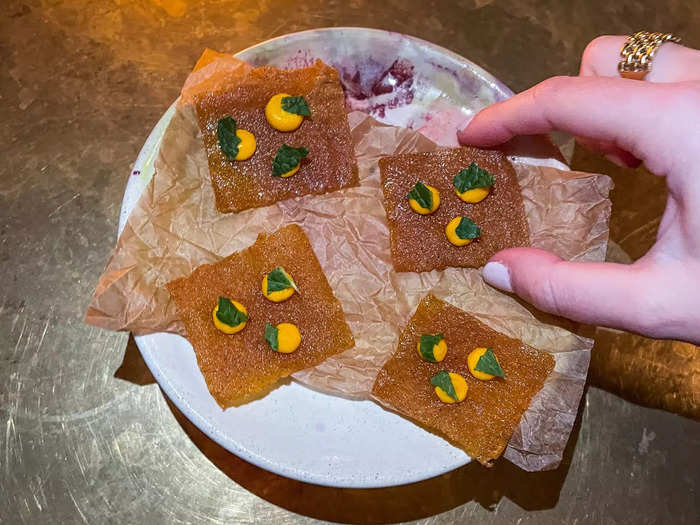
Also before the main courses came out, this plate of carrot "Pringles" was delivered by an excited employee.
The chips were made with tapioca flour, carrot, garlic, and caraway, which all got cooked down into a broth, which then got turned into a chip, according to our server. On top was a small dollop of tofu and carrot emulsion garnished with a piece of fresh mint.
Following instructions, we popped these into our mouths with our hands. They were salty and somewhat herby, with the mint adding a lot of freshness. The chips were extremely thin, which was fun to eat, and they were semi-sweet in flavor. We both thought the carrot dollop had a little kick to it, which added variety to the overall taste.
Our first courses arrived and we both dove into the beautifully-plated food.
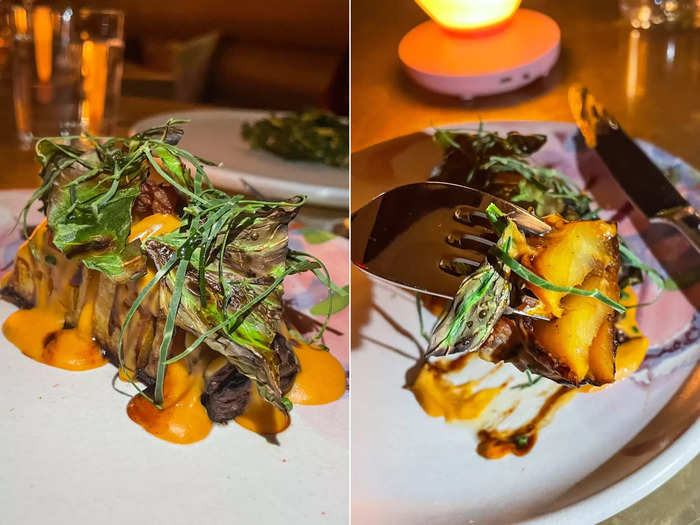
The rutabaga was recommended by our server, so of course I ordered it. This root veggie was cut hasselback-style, brushed with a house-made Worcestershire sauce, and topped with Swiss beer cheese, pancetta, and collard greens two ways.
The cheese was made with Emmentaler Swiss and Narragansett Lager. It had kind of a mealy texture to it — I would have loved something more smooth, but it wasn't bad.
When I tried the pancetta, I was blown away. The HAGS team had been curing this pancetta since August, and a server came around to tell us this was the last of Gibson the pig. It was cut into tiny cubes that dissolved when I took a bite — so beautiful. The flavors were really robust and each cube was super crispy, but not hard and crunchy.
Gibson, I'm honored to have experienced your legacy.
The collard greens were served raw and as chips, which were crispy. I left wanting to make them at home as a snack.
Overall, this veggie behaved like a potato, it was velvety and soft inside while still maintaining its structure. I thought the textures of this dish were wonderful. The flavors were rich and heavy, which would have made this great for even a single-course dish at a restaurant.
My friend ordered the broccolini for this course, which also came at the server's recommendation.
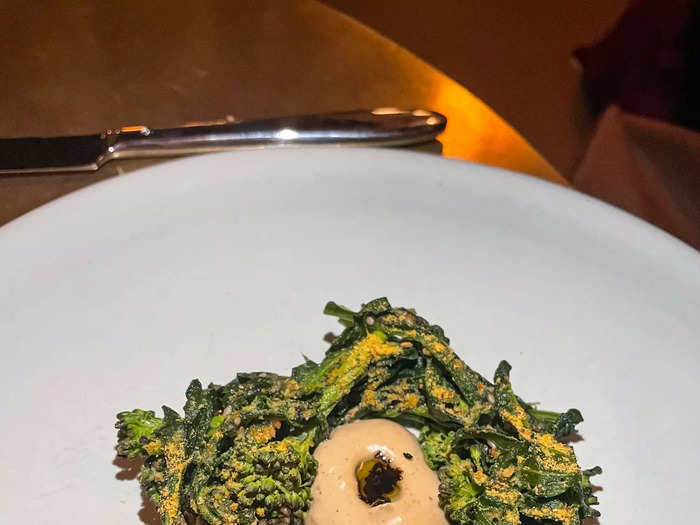
The dish was a combination of broccoli Di Cicco and spigarello, topped with marcona almonds and sesame oil. The veggies were topped with a nutritional yeast and sesame powder. In the center was a marcona almond vinaigrette as well as a sauce made from Töst fermented white tea, oil, and vinegar with some Urfa chili in the center.
The vegetables were perfectly charred, and the sauce added a light layer of richness, which was balanced out by some more vinegary sour notes. I hadn't really experienced nutritional yeast before, and I felt it had a flowery flavor profile to it that reminded me more of dried marijuana buds than a more floral bouquet.
Course No. 2 came out with some bright colors, and mine featured a tableside saucing.
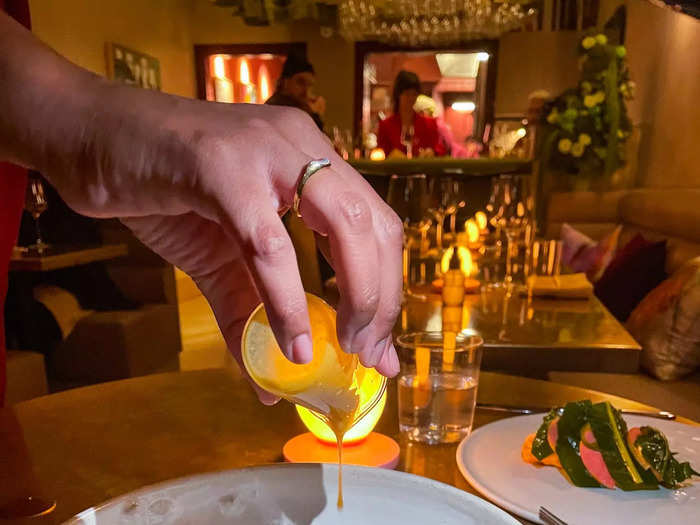
This course really brought the drama. I ordered the tempeh, which came brushed with a caramelized onion and sorghum jam. It was topped with roasted cipollini onion and Delfino cilantro, and served next to a koginut squash confit in olive oil and thyme.
A "gold sauce" was poured on top once my plate hit the table. The sauce was made of caramelized onion, garlic, shallot, curry leaf, bay leaf, and coconut milk. "All the good stuff," as our server put it. It had the flavor profile of a mild curry sauce.
The pasteurized tempeh was extremely soft and creamy inside, which I hadn't experienced with this protein before. The onions were a nice, sweet touch, and the squash was a star on the plate with its softness and citrusy flavor profile.
My friend, who eats tempeh a lot in her own diet, said this was "hands-down the best tempeh I've ever had."
We also tried the steelhead trout, which had been slowly baked and covered in an olive tapenade.
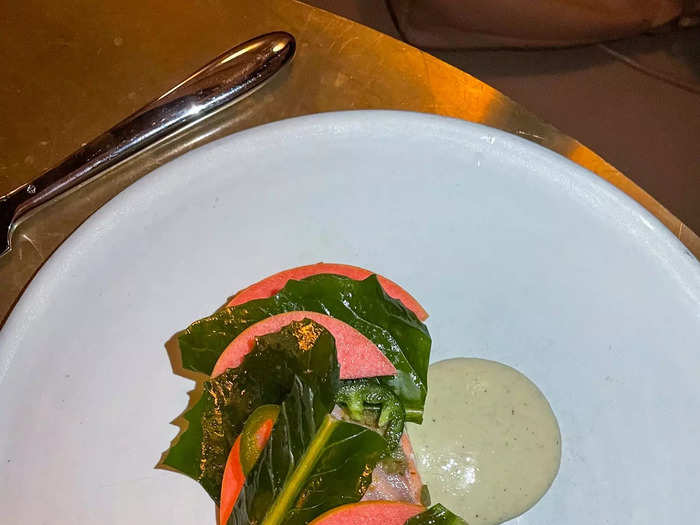
On top, there were dandelion greens, raw jalapeño, and slices of raw pink Mountain Rose apple. The dish was served with a fermented jalapeño and tofu emulsion on the side.
While it was difficult to eat all components at once, I thought each of the flavors and textures worked well together. I wished the olives were a little more powerful and provided more of a salty brininess. However, the fish was moist, flaky, and cooked beautifully.
The side sauce was super refreshing and tasted, strangely, exactly like what you'd imagine cucumber ice cream would taste like.
The jalapeño, greens, and apple didn't really provide much flavor. Listening to all the ingredients, I expected it to be a POP! POP! POP! of explosive acidity and heat, but that wasn't the case. There was no heat to the jalapeño, but there was the flavor profile of what a jalapeño would be without the spice, which I thought was cool to experience on its own.
Our third courses were each tasty, filling, and imaginative.
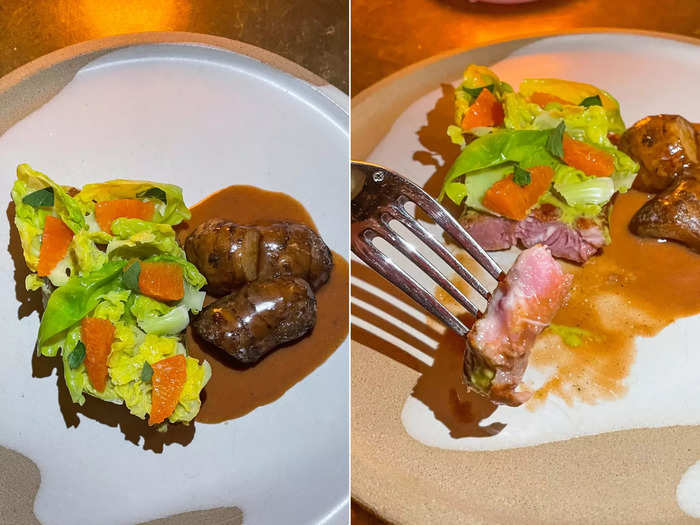
For this course, I ordered the pork steak, which had been pressed overnight and slowly roasted. On top was a salad of blanched brussels sprouts. The protein was dressed with a citrus-forward, Italian herb sauce, and topped with cara cara oranges, chives, and fresh-picked oregano. The meat was served with sunchokes confit (using butter) and then dressed with a brown butter jus made with pork drippings and red wine.
I loved the way the brussels were dressed. It was an even and super-light layer of flavor that I could feel but couldn't see.
When I tried the pork, I found the texture to be like that of a beef steak. It was soft, and its flavors reminded me more of beef than pork.
The sunchoke soaked up the jus and took on its flavors beautifully. I loved that the skin was still on, and how it was both buttery soft and firm in the middle like a perfectly boiled potato.
The mushroom course consisted of two fungi: pan-seared maitake mushrooms, and lion's mane poached in olive oil and smoked soy.
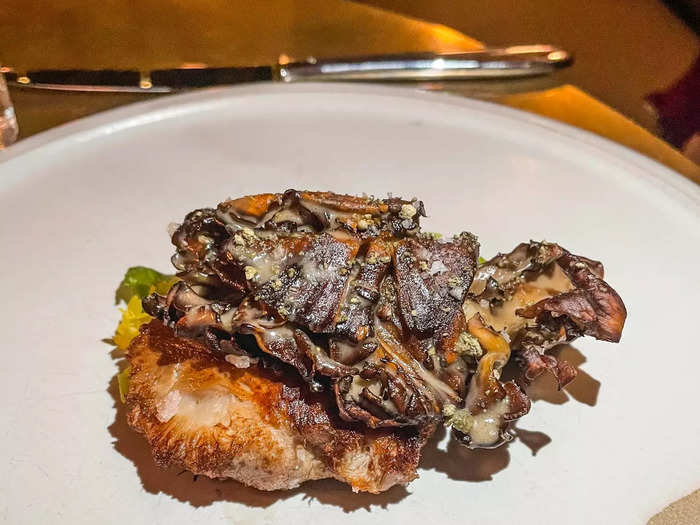
The mushrooms were served with a celery root Madeira emulsion and raw celery stems.
We were surprised by the lion's mane — in a very good way. It was somehow mushy and light at the same time, and a server told us a guest once asked if it was foie gras. "'I feel like I'm eating a jellyfish," my friend said (insert childlike laughter filled with delight). The flavors were sour and wonderfully acidic in a vinegar-forward way.
In a sharp but welcome contrast, the maitake had a completely different flavor profile. It was really strong and smokey, with heavy umami. As a diner, I thought this was a really cool juxtaposition to experience.
"I could eat these mushrooms every day of my life," my dinner partner said.
Then it was time for the cheese course, which I was personally excited about.
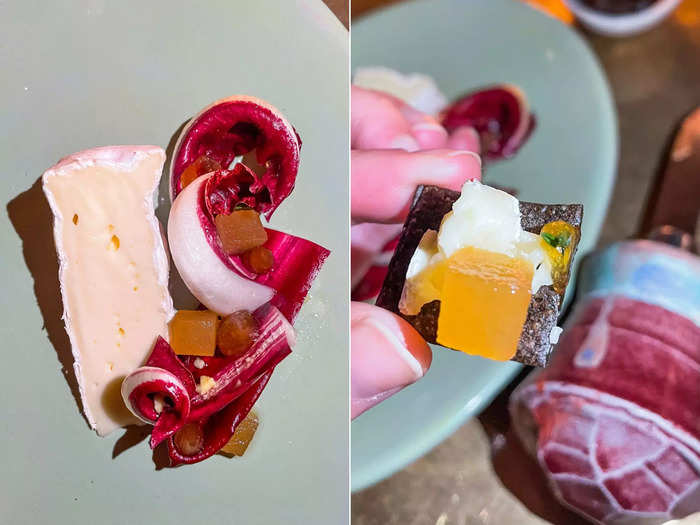
Diners are given the option of a vegan cashew-based cheese, or a cow's milk cheese. We both went with cow.
Before we even saw the dairy, two cheese knives were brought to the table. They were fun and went with the artisan vibe.
We were presented with Moses Sleeper, a brie-style cow's milk cheese from Jasper Hill Farm in Vermont. It was served with tardivo leaves as well as red pears that had been poached in a charred ginger and maple syrup. The chef also turned the poaching liquid into a gel that was served on the plate.
A small bowl of vegetable ash crackers accompanied the dish. These were made by "burning the tardivo to hell" and then using the ash to make crackers, our server told us.
The gel acted like a marmalade, which provided a welcome sweetness. The cheese was soft but not melty, lightly creamy, and not too rich, and it spread well on the crackers, which tasted only slightly like burnt vegetables.
I thought the tardivo's bitterness was very powerful in a good way, and the pear was a great addition in terms of both flavor and texture.
Dessert was a true delight and a great way to end this meal.
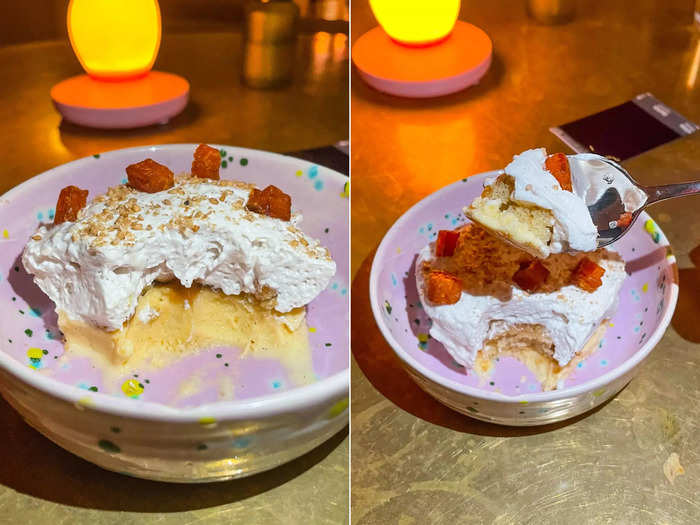
For dessert, I opted for the satsuma sherbet. It came topped with a sesame oil cake, a layer of root beer gel, and a coconut milk cloud, which was topped off with candied yams and toasted sesame seed crumble.
There were so many surprising things in here, and each bite was better than the one before.
I thought the coconut cream was very true-to-flavor while taking on a light-as-air whipped cream form. The sherbet was bright and delicious, and had a soft rather than icy texture. The root beer gel was made using candy root beer bottles as the flavor base. An employee told us they tried to make the gel flavor with sarsaparilla root but it tasted "way too medicinal" and not like the nostalgic root beer flavor they wanted.
The flavors here were all so different from one another. The combination seemed absolutely bizarre to me, but somehow it worked wonderfully.
On the other plate, a playful squiggle of chocolate ganache was topped with a banana cream gel, house-made vanilla shortbread cookies, and aquafaba meringue.
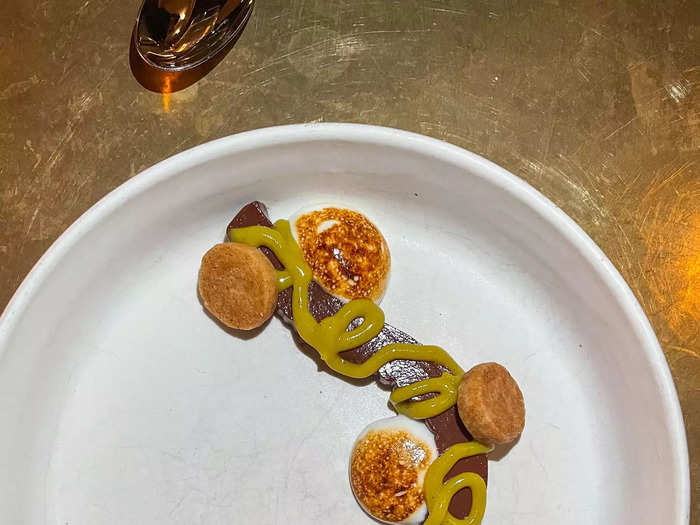
The gel had a real banana flavor rather than an artificial one. I thought the ganache was almost gelatin-like in texture — it reminded me of the thin layer of skin on top of Jell-O chocolate pudding both in texture and flavor, which I love. The cookie was so flavorful with both buttery notes and hints of vanilla.
I loved how well the flavors and textures worked when I took a bite of all components together.
Well, what a great end to the meal, we thought.
We were wrong. There was more!
Our check came with a side of homemade cosmic brownies and a Polaroid photo.
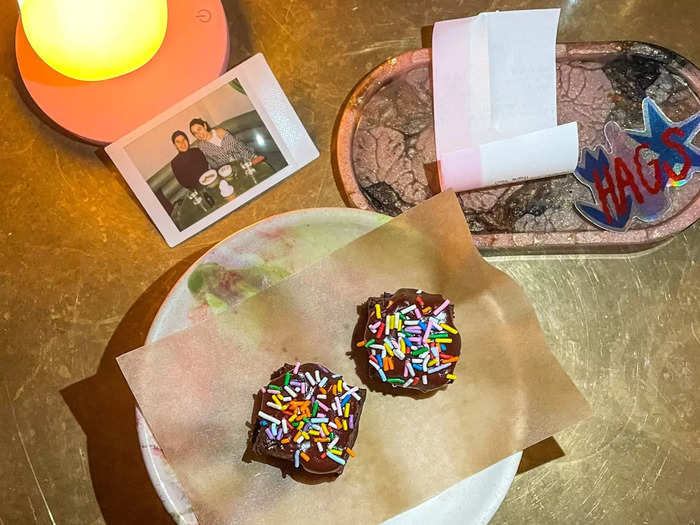
As we were photographing our dessert, a server told us that they take Polaroids for all guests at the end of the meal. They took our photo and it developed by the time we finished the course.
Our server brought the check to our table on a pink and gold shimmery resin tray with two HAGS stickers as a parting gift.
Simultaneously, a plate of brownies — an homage to the Little Debbie Cosmic Brownies of our childhood — graced our table. They were fudgy, dripping with ganache, and topped with brightly colored sprinkles. The chocolate flavor was pleasantly bitter, which was a better cap to the meal than a super-sweet treat would have been, in my opinion.
By the end of this five-plus course meal, we were definitely full. There was a lot of richness in the dishes, but not in an overwhelming way.
The words "classy homestyle" feel like they capture the overall tone of the cuisine coming out of Justice's kitchen. We felt cared for and loved through the food, the way you do after you're fed a home-cooked meal. And I think that speaks to the ultimate goal of HAGS.
I went to check out the bathroom, as I usually do, and I was again reminded that I was in a queer-minded space. It was wonderful.
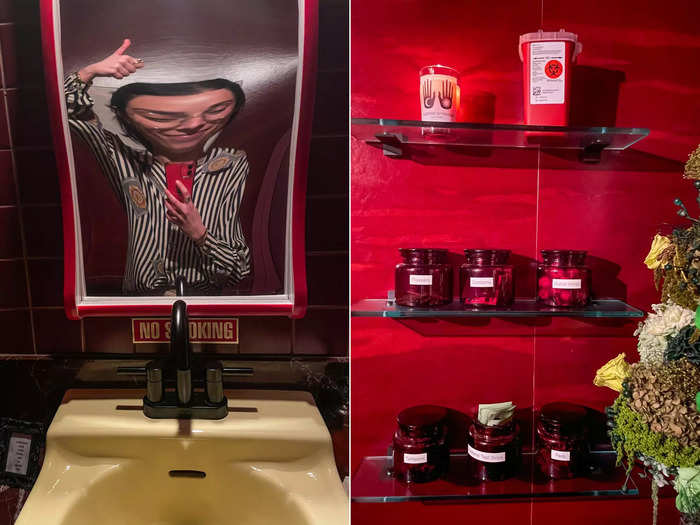
Before it was time to head home, I wanted to go check out the bathroom. I always feel like I get some extra intel about a restaurant when I look around and see what their restrooms are like.
The fun-house mirror that was certainly not conducive to a hair check or makeup touch-up told me that HAGS wants me to know I look great the way I am. I saw shelves of items that catered to the people who would be walking in here: tampons, pads, condoms, flossers, mints, fentanyl test strips, and a medical waste disposal container.
This eatery reaches far beyond good food, and the lasting impact is all in the details. It's a fine-dining restaurant that takes care of its community. It lets you know it's there for you while also being relaxed enough for others to still feel welcome. HAGS is a self-proclaimed restaurant "by queer people, for all people" — and it shows.
Experiencing a meal at HAGS challenged my own perception that fine dining is stiff, for the elite, and focused only on food. It made me excited for the future of fine dining and all the chefs who have yet to make their mark.
Popular Right Now
Advertisement